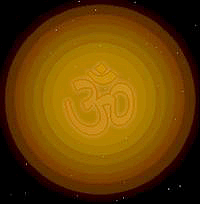

Zitierweise / cite as:
Payer, Alois <1944 - >: Dharmashastra : Einführung und Überblick. -- 10. Sakramente und Übergangsriten (samskara). -- Anhang A: Mondhäuser (Nakṣatra). -- Fassung vom 2006-03-15. -- URL: http://www.payer.de/dharmashastra/dharmash10a.htm -- [Stichwort].
Erstmals publiziert: 2004-02-18
Überarbeitungen: 2006-03-15 [Umsetzung auf Unicode]
Anlass: Lehrveranstaltung 2003/04
Unterrichtsmaterialien (gemäß § 46 (1) UrhG)
©opyright: Dieser Text steht der Allgemeinheit zur Verfügung. Eine Verwertung in Publikationen, die über übliche Zitate hinausgeht, bedarf der ausdrücklichen Genehmigung der Herausgeberin.
Dieser Teil ist ein Kapitel von:
Payer, Alois <1944 - >: Dharmashastra : Einführung und Übersicht. -- http://www.payer.de/dharmashastra/dharmash00.htm
Dieser Text ist Teil der Abteilung Sanskrit von Tüpfli's Global Village Library
Die Mondhäuser sind Bestandteil der indischen Astrologie. Die Bedeutung der Astrologie in Indien schildern folgende drei Zitate:
"Mehr als in anderen Kulturen ist in Indien die Astrologie ein wesentlicher Bestandteil des täglichen Lebens. Fast jeder Inder sucht wenigstens einmal im Leben -- in der Regel vor der Eheschließung -- einen Astrologen auf, und über 60 Prozent der Bevölkerung konsultieren ihn regelmäßig. Die indische Gesellschaft ist geprägt durch eine starre Klasseneinteilung, die es fast unmöglich macht, aus der Kaste auszubrechen, in die man hineingeboren wurde. Vielleicht besitzen die Inder daher ihren Hang zum Fatalismus. Viele glauben an die Vorbestimmung, die ihnen wenig freie Wahl und kaum einen eigenen Willen gestattet. Daher ist ihnen die Beschäftigung mit Astrologie wichtig. Mit ihrer Hilfe versuchen sie, die Zukunft zu erforschen und drohendes Unheil abzuwenden.
Während der Astrologe lm Westen oft als Scharlatan abgetan wird, ist sein Beruf in Indien sehr ehrbar. Wahrsager wie Anand Shankar Vyas aus Udschain sind heute Menschen mit Macht und Einfluss und berechnen hohe Honorare. Leute mit bescheidenen Mitteln suchen weniger berühmte Astrologen auf.
Unabhängig von seiner Stellung ist das Wort eines Astrologen in Indien buchstäblich Evangelium. Hochzeiten wurden schon wegen astrologischer Warnungen abgesagt, und arme, einfache Inder haben sogar Kinder geopfert, um dadurch drohendes Unheil abzuwenden."
[Die Astrologie / von der Redaktion der Time-Life Bücher. -- Amsterdam : Time-Life, ©1989. -- (Geheimnisse des Unbekannten). -- ISBN 90-6182-999-2. -- S.137]
"In Indien durchdringt also Astrologie immer noch alle Bereiche des Lebens. "Denn nicht nur bei religiösen Zeremonien sind kosmische Konstellationen entscheidend, sondern auch bei scheinbar banalen Alltagshandlungen. Auf dem Lande ist der Jyotishi, der Astrologe, eine selbstverständliche Instanz wie der Arzt oder der Priester. Er, der die Geburtshoroskope von allen aus dem Dorf kennt, entscheidet, wann jeder Bauer säen, ernten, ein Haus bauen, einen Teppich weben, sein Kind in die Kaste aufnehmen soll. In den Luxus-Hotels der Großstädte residieren Astrologen, um dienstreisende Manager vor Business-Verhandlungen zu beraten. Und in der hohen Politik sorgt astrologische Intervention mitunter für so groteske Situationen wie anno 1996. Der damalige Premierminister Deve Gowda hatte sich nach der Wahl von seinem Astrologen den optimalen Tag für den Umzug in die Regierungsresidenz errechnen lassen. Die Wahl fiel auf den 7. Juni. Der Einzug verlief allerdings weniger feierlich als erwartet, denn Gowdas Vorgänger Narasimha Rao hielt die Räume noch besetzt -- dessen Astrologe hatte dringend geraten, nicht vor dem 10. Juni auszuziehen.
«Ohne Astrologen gerieten die Stunden... in heillose Verwirrung... Keiner, der glücklich sein will, sollte in einer Gegend leben, wo es keine Sterndeuter gibt, denn der Astrologe ist das Auge des Landes, und wo er wohnt, geschieht kein Unglück.» Diese Sätze des Varaha Mihira, der um 550 n. Chr. gewirkt hat, gelten in Indien noch immer.
Und noch immer stammen die bedeutenden Sternkundigen aus der Kaste der Brahmanen. Kryshan Charak hat sein erstes Horoskop für andere, als er 15 war, unter Anleitung seines Großvaters gestellt. Heute ist der Spross einer gelehrten Brahmanenfamilie aus dem Dorf Nugran in Kaschmir 50 und hauptberuflich Chefarzt der Chirurgie in einem Krankenhaus von Delhi; daneben Autor astrologischer Lehrbücher und Herausgeber der Zeitschrift Vedic Astrology.
Zwei Jahre lang hat Charak in England als Chirurg gearbeitet. Mit seinem glatt rasierten Gesicht und dem grauen Pullover über der grauen Hose entspricht er eher dem Wissenschaftler als dem Guru-Klischee. Seine absolute Gewissheit, «dass Astrologie funktioniert, auch wenn wir nicht wissen wie», vergleicht er mit der Erfahrung der Schwerkraft. «Wenn ich etwas fallen lasse, kommt es unten an ganz egal, ob ich die Gravitationsformel kenne oder nicht.» Ist eine spezielle Energie die Ursache? «Das ist irrelevant», sagt er. «Für mich ist es wichtig, die Sprache des Kosmos zu studieren und anzuwenden.»
Fünf bis sieben Jahre intensiver Auseinandersetzung sind notwendig, um die Feinheiten dieser «Sprache» zu erlernen. Beispiel für die praktische Anwendung ist die «Koota-Prozedur», mit der die überwiegende Mehrheit der Hindus bis heute vor der Heirat die Horoskope abstimmen lässt. Meist legen die Eltern des Bräutigams dem Astrologen die «Bio-Daten» potenzieller Bewerberinnen vor, bevor der Sohn die Zukünftige persönlich kennen gelernt hat. Acht Faktoren der beiden Geburtskonstellationen vergleicht der Jyotishi in komplizierten Berechnungen, bis zu 36 Punkte verteilt er. Ab 24 Punkten gilt die Paarung als hervorragend, unter zwölf Punkten als nicht empfehlenswert. «Wenn der Astrologe abrät, wird es keine Hochzeit geben», sagt Charak.
Die indische Astrologie, die sich auf die 3700 Jahre alten Schriften der Veden beruft, arbeitet mit dem so genannten siderischen Tierkreis -- wer heute im Westen als Widder zur Welt kommt, ist nach indischer Rechnung Fisch. Außerdem spielen Tausende spezielle Planetenkonfigurationen eine Rolle; dazu Nakshatras, die vom Mond bestimmt werden; Dashas, die Lebensperioden bezeichnen, in denen ein Planeteneinfluss sich auswirkt und eine Fülle anderer im Westen unbekannter Details.
Der wesentliche Unterschied ist jedoch prinzipiell. «Ohne den Reinkarnations-Gedanken kann man Astrologie nicht würdigen», glaubt Kryshan Charak. Das hinduistische Karma-Prinzip weist jedem Menschen im Zeit-Kontinuum eine persönliche Rolle zu, die sich im nächsten Leben fortsetzt.
Der Astrologe liest aus dem Geburtshoroskop die Schicksalskoordinaten seiner Kunden und hilft, die Freiräume innerhalb der kosmisch gesetzten Grenzen zu nutzen.
- Soll sich meine Mutter operieren lassen?
- Soll ich meinen Nachbarn verklagen?
- Wann ist der ideale Zeitpunkt für eine Reise,
- einen Autokauf,
- einen Stellenwechsel?
Das Vertrauen in astrologischen Rat gibt den Klienten die subjektive Sicherheit, in diesem Leben das Bestmögliche für das nächste zu tun. Das bewirkt Gelassenheit und Geduld -- selbst wenn Elend den eigenen Alltag bestimmt."
[Tügel, Hanne: Mythos und Macht der Sterne. -- In: Geo. -- ISSN 9342-8311. -- 5 (2001-05). -- S. 109f.]
"Der biologische Aspekt, den die gesellschaftliche Matrix der indischen Astrologie umschließt, ist zweifelsohne derjenige, der den Lebenszyklus umfasst. In der Tat findet kein einziges wichtiges Ereignis im Leben eines Menschen statt, das nicht in der Astrologie seine Entsprechung hat; mit anderen Worten, das Individuum wird von der Geburt bis zum Tode von einem astrologischen Experten begleitet. Innerhalb eines Zeitraumes von etwa einem halben bis einem Jahr nach der Geburt wird das sogenannten Geburtshoroskop (Janen kundali) angefertigt, das das provisorische Horoskop, das kurz nach der Geburt berechnet wurde und das lediglich die Planetenkonstellationen zum Zeitpunkt der Geburt, aber keinerlei Vorhersagen etc. enthält, ablöst und fortan so etwas wie die »Entscheidungsgrundlage« des Individuums darstellt.
Sämtliche weitere, aufgrund der biologischen Reifung des Individuums entstehende Veränderungen werden nach diesen astrologischen Maßgaben konzertiert, d.h. beispielsweise, dass der Astrologe einen Heiratstermin festlegt, von dem angenommen wird, dass von der für diesen Tag berechneten Planetenkonstellation günstig Einflüsse auf das zukünftige Zusammenleben des jungen Ehepaares ausgehen. Doch schon bevor dieser Termin festgelegt wird, wirkt der Astrologe bei der Auswahl des zukünftigen Ehepartners mit: durch Überprüfung der Geburtshoroskope beider Heiratskandidaten wird festzustellen versucht, ob die Ehe Aussicht auf Erfolg verspricht, d.h. in erster Linie, ob die möglichen Ehepartner charakterlich zueinander passen, ob sie Kinder -- insbesondere Söhne -- haben werden und, was zunehmende Bedeutung erlangt hat, ob mit der Heirat auch ein finanzieller Vorteil verknüpft ist. Für den Fall, dass der Astrologe zu der Überzeugung gelangt, dass die Heiratskandidaten aus einem der genannten Gründe nicht zueinander passen, findet die Hochzeit auch nicht statt, und die Eltern der Betreffenden müssen sich nach einem anderen potentiellen Ehepartner für ihre Tochter bzw. ihren Sohn umsehen.
Doch die Eingriffsmöglichkeiten des Astrologen reichen noch direkter in die Intimsphäre der Menschen, so beispielsweise bis hin dazu, dass günstige Zeitpunkte für die Ausübung sexuellen Verkehrs der Ehepartner festgelegt werden, um die Zeugung männlicher Nachkommen sicherzustellen.
Die Beratung in Eheangelegenheiten, angefangen vom Arrangement der Ehe bis hin zur Regelung des sexuellen Verkehrs, nimmt nach übereinstimmender Auskunft aller astrologischen Experten, die ich befragte, einen breiten Raum in ihrer täglichen Praxis ein.
Auch der Umgang mit dem Tod richtet sich nach astrologischen Maßgaben. Dies beginnt beispielsweise schon mit der Vorschrift, dass die Leichenverbrennung entweder noch am Todestag oder aber, falls der Tod nach Sonnenuntergang eingetreten ist, am darauffolgenden Tag nach Sonnenaufgang zu geschehen hat. Ebenfalls die Trauerperiode, die sich in der Regel über zwölf Tage erstreckt -- bei manchen Kasten auch über 30 Tage --, ist nach astrologischen Vorgaben gegliedert und kann, falls die überaus wichtige Abschlusszeremonie mit einer ungünstigen planetarischen Konstellation zusammenfällt, entsprechend verkürzt werden.
Mit diesen Beispielen ist die Liste derjenigen astrologischen Aktivitäten, die mit dem Lebenszyklus verknüpft sind, bei weitem noch nicht erschöpft, auf eine ausführlichere Darstellung muss hier jedoch verzichtet werden, denn man könnte damit ohne Schwierigkeiten mehrere umfangreiche Bände füllen. ...
Von diesen grundlegenden Erfahrungselementen einmal abgesehen, lässt es sich darüber hinaus im indischen Alltag nur äußerst schwer vermeiden, mit astrologischen Aspekten aller Art in Berührung zu kommen. Astrologische Maßgaben spielen nicht nur bei vergleichsweise außerordentlichen Ereignissen wie Hochzeit oder Einweihung eines neuen Hauses und dergleichen eine Rolle, sondern auch bei der Organisation der täglichen Routine.
So gibt es systemgemäß buchstäblich für jede Alltagsaktivität, angefangen vom morgendlichen Puja für die das Haus beschützende Gottheit (in der Regel die Gottheit, die auch für die Kaste der Betreffenden »zuständig« ist) bis hin dazu, wann man das abendliche Essen einnimmt, »günstige« und »ungünstige« Zeitpunkte. Mit anderen Worten, die alltägliche Erfahrung ist vollständig durchdrungen von astrologischen Elementen und wenn es auch jedem freistehen mag, den Umfang der im Alltag zu befolgenden astrologischen Maßgaben selbst festzulegen, so bedeutet das noch längst nicht, dass die Erfahrungen mit dem gesamten System, wie in den meisten »westlichen« Gesellschaften, eher marginaler Natur sind. Darüber hinaus wäre eine vollständige Befolgung aller aufgrund astrologischer Berechnungen festgelegten Regelungen auch schlicht unmöglich, denn man könnte wortwörtlich keinen Schritt unternehmen, ohne nicht vorher einen Experten konsultiert zu haben. Dies kann, so meine ich, ohne weiteres als der neurotische bzw. zwanghafte Aspekt der Astrologie angesehen werden".
[Karrer, Peter: Die Götter, die Menschen und das Geld: Astrologie in Nordindien : eine Studie über astrologische Praktiker aus zwei miteinander konkurrierenden Kasten - Dakots und Brahmanen. -- Frankfurt (Main) : R. G. Fischer, ©1991. -- ISBN 3894064684. -- S. 140 - 143. -- {Wenn Sie HIER klicken, können Sie dieses Buch bei amazon.de bestellen}]
Eine kurze Einführung in die indische Astrologie findet man in:
Payer, Margarete <1942 - >: Internationale Kommunikationskulturen. -- 12. Kulturelle Faktoren: Zeit, Pünktlichkeit, Verlässlichkeit. -- 3. Ostasiatische und südasiatische Kalender und Zeiten. -- URL: http://www.payer.de/kommkulturen/kultur123.htm. -- Zugriff am 2004-02-11
Vergleicht man den Aufgang eines Fixsterns mit dem Aufgang von Mond (oder Sonne), so sieht man, dass die Fixsterne jeden Tag etwas früher als Sonne bzw. Mond aufgehen. Mond (und Sonne) scheinen deshalb rückwärts (gegenüber ihrer täglichen Bahn) unter den östlichen Rand der Horizontebene zu gleiten. Der Mond braucht 27 Tage plus 8 Stunden, um wieder dieselbe Stellung bezüglich der Fixsterne zu erreichen, inbezug auf die Stellung zur Sonne braucht der Mond aber 29½ Tage, um wieder in dieselbe Stellung zu kommen. (Die Sonne braucht inbezug auf die Fixsterne 365¼ Tage, um wieder in dieselbe Stellung zu kommen.)
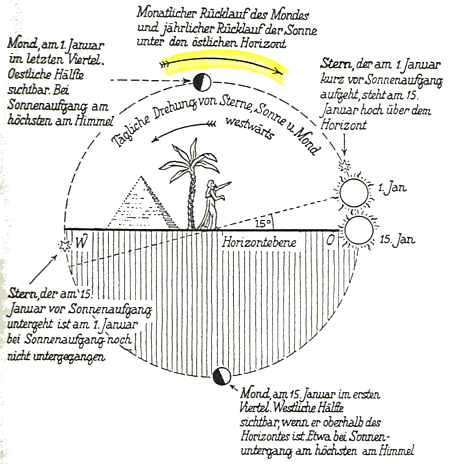
Abb.: Rücklauf von Mond und Sonne bezüglich der Fixsterne
[Bildquelle: Hogben, Lancelot Thomas <1895 - 1975>: Mensch und Wissenschaft : Die Entstehung und Entwicklung der Naturwissenschaft aus den sozialen Bedürfnissen. Ein Buch zur Weiterbildung. -- Zürich : Artemis. -- 2 Bde. -- Originaltitel: Science for the citizen (1938). -- Bd. 1. -- 1948. -- S. 25.]
Wegen dieser relativ zum Fixsternhimmel rückläufigen Bewegung durchlauft die Sonne in 365¼ Tage scheinbar einen Kreis von Sternbildern. Der Kreis, der der Ebene der Erdumlaufbahn um die Sonne entspricht, heißt Ekliptik. Die 12 wichtigsten Sternbilder Tierkreis (Zodiac).
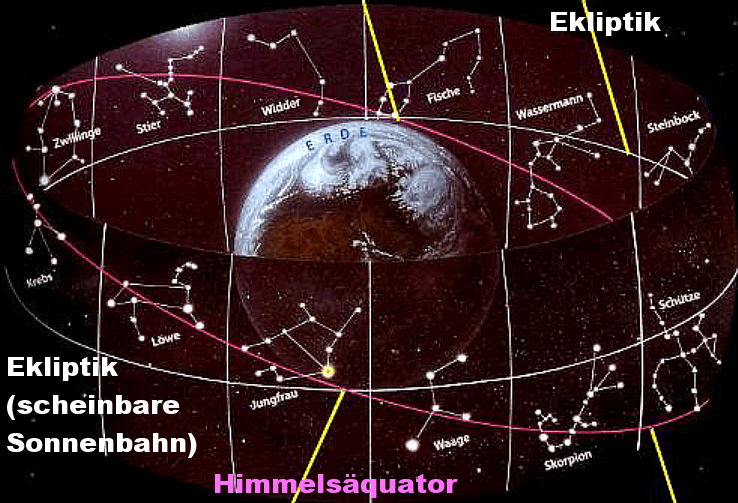
Abb.: Die Ekliptik [Bildquelle:
http://www.miss-spica.de/Sternbilder/body_stbilder.html. --- Zugriff am
2004-02-08]
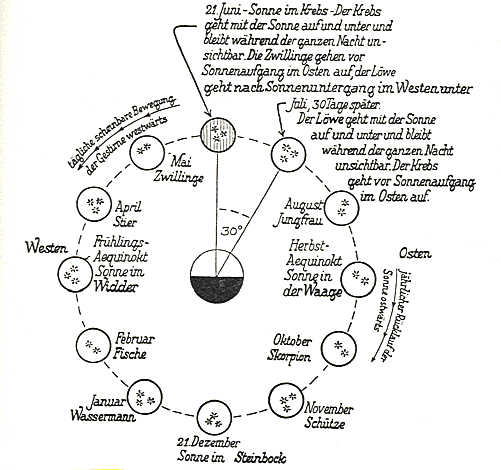
Abb.: Der jährliche (scheinbare) Rücklauf der Sonne längs der Sternbilder des
Tierkreises
[Bildquelle: Hogben, Lancelot Thomas <1895 - 1975>: Mensch und Wissenschaft : Die Entstehung und Entwicklung der Naturwissenschaft aus den sozialen Bedürfnissen. Ein Buch zur Weiterbildung. -- Zürich : Artemis. -- 2 Bde. -- Originaltitel: Science for the citizen (1938). -- Bd. 1. -- 1948. -- S. 37.]
Der Mond durchläuft in 27 Tagen plus 8 Stunden eine Reihe von Sternzeichen am Himmel. Da die Mondbahn gegenüber der Ekliptik (Ebene der Erdbahn um die Sonne) ca. 5 Grad geneigt ist, durchläuft der Mond nicht genau die Ekliptik, sondern bewegt sich in einer Welle um die Ekliptik.
"Der Mond scheint an der allgemeinen Bewegung der Himmelskugel teilzunehmen; er geht im Osten auf und im Westen unter. Wenn er gleichzeitig mit einem bestimmten Sternbild aufgeht, so wird dasselbe in der darauffolgenden Nacht etwas früher als der Mond erscheinen. Eine Woche später steht das Sternbild beim Mondaufgang schon in der Nähe des Poles. So scheint der Mond selber in entgegengesetzter Richtung der scheinbaren Drehung der Sonne und der Fixsterne nach rückwärts zu gleiten, so dass er nach einer bestimmten Anzahl Tage und Nächte an die Stelle zurückkehrt, wo er am Anfang war. Die verflossene Zeit nennen wir kurz einen Monat. Umgekehrt können wir sagen, dass der Mond in einem Monat einmal in der gleichen Richtung der täglichen Erddrehung um die Erde kreist. Wie wir es auch betrachten, der Mond hat seine eigene Bewegung, die von der scheinbaren Bewegung der Fixsterne unabhängig ist." [Quelle: Hogben, Lancelot Thomas <1895 - 1975>: Mensch und Wissenschaft : Die Entstehung und Entwicklung der Naturwissenschaft aus den sozialen Bedürfnissen. Ein Buch zur Weiterbildung. -- Zürich : Artemis. -- 2 Bde. -- Originaltitel: Science for the citizen (1938). -- Bd. 1. -- 1948. -- S. 29.]
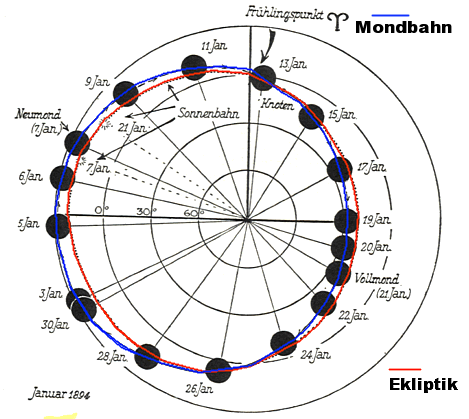
Abb.: Mondbahn gegenüber dem Fixsternhimmel innerhalb von 27 1/3 Tagen
[Bildquelle: Hogben, Lancelot Thomas <1895 - 1975>: Mensch und Wissenschaft : Die Entstehung und Entwicklung der Naturwissenschaft aus den sozialen Bedürfnissen. Ein Buch zur Weiterbildung. -- Zürich : Artemis. -- 2 Bde. -- Originaltitel: Science for the citizen (1938). -- Bd. 1. -- 1948. -- S. 111.]
In Indien hat man die rückläufige Bahn des Mondes durch die Fixsterne in 27 Abschnitte eingeteilt (da er ca. 27 Tage dazu braucht), die sog. Mondhäuser (Nakṣatra). Später hat man als Ausgleich für die 8 Stunden überschüssige Differenz des Rücklaufs gegenüber 27 Tagen noch ein 28. Mondhaus hinzugefügt.
Die 27 Mondhäuser sind:
Später hat man, um den Fehler auszugleichen, der dadurch entsteht, dass der Mond fast 8 Stunden länger als 27 Tage für den Rücklauf durch den Fixsternhimmel braucht, zwischen Uttarāṣādā (Nr. 21) und Śravaṇā (Nr. 22) ein 28. Mondhaus eingefügt: Abhijit (α, ε und ζ Lyrae [Leier]).
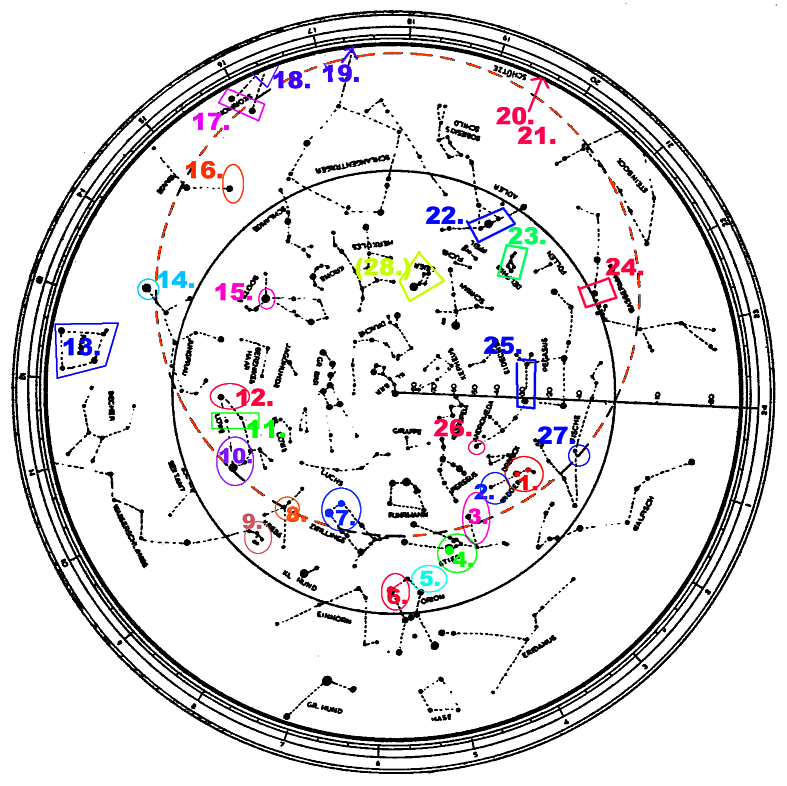
Abb.: Lage der Identifikationssterne der Mondhäuser (1. - (28.))
[Quelle der unterlegten Sternkarte: Schroeder, Wolfgang: Praktische Astronomie für Sternfreunde. -- Stuttgart : Franckh, 1958. -- 180 S. : Ill. -- Originaltitel: Practical Astronomy (1956). -- S. 169]
Die Identifikation der Leitsterne der Nakṣatras habe ich aus der Literatur übernommen und nicht selbst überprüft.
Zum Verständnis der westlichen Sternennamen in der Liste der Mondhäuser:
"Die Namen der Sterne Die Astronomen früherer Zeiten gaben den meisten helleren Sternen besondere Namen. Viele dieser Namen werden auch heute noch benutzt. So sprechen wir von Kastor, Pollux, Procyon, Atair und Antares, alles Sterne, die ihre Namen den Griechen verdanken. Die Araber benannten andere Sterne, wie Beteigeuze, Rigel, Aldebaran und Deneb. Viele Namen von schwächeren Sternen sind arabischen Ursprungs: Zuben el Genubi, Benetnasch, Algenib, Mirfak und Ras Alhague.
Da es sinnlos ist allen sichtbaren Sternen Eigennamen zu geben, hat der deutsche Astronom Johannes Bayer (1572—1625) ein System eingeführt, mit dessen Hilfe die Fixsterne eindeutig bezeichnet werden.
Der hellste Stern jedes Sternbildes wird nach dem ersten Buchstaben des griechischen Alphabets benannt, der zweithellste Stern nach dem zweiten Buchstaben usw. Von dieser Regel gibt es einige Ausnahmen, die aus Bequemlichkeitsgründen gemacht wurden, so z. B. in Ursa Major (dem Großen Bären). Aber im allgemeinen ist die Bezeichnung der Sterne mit den griechischen Buchstaben in der Reihenfolge der absteigenden Helligkeit auch heute noch üblich. Beteigeuze, der hellste Stern im Orion, wird α (alpha) Orionis genannt, der zweithellste, Rigel, ß (beta) Orionis. Wega, der hellste Stern in der Leier ist α (alpha) Lyrae usw. Dem griechischen Buchstaben folgt dabei immer der Name des Sternbildes im Genetiv. Beteigeuze ist übrigens ein veränderlicher Stern und strahlt nur zeitweise heller als Rigel.
Sind die Buchstaben des griechischen Alphabets in einem Sternbild aufgebraucht, werden für die schwächeren Sterne Zahlen benutzt, gemäß einem System, das von dem ersten englischen Hofastronomen Flamsteed eingeführt wurde. Es gibt noch einige andere Systeme zur Bezeichnung der verschiedenen Sterne."
[Quelle: Schroeder, Wolfgang: Praktische Astronomie für Sternfreunde. -- Stuttgart : Franckh, 1958. -- 180 S. : Ill. -- Originaltitel: Practical Astronomy (1956). -- S. 17f.]
Im Folgenden beispielhaft einige Mondhäuser im Detail

Abb.: Nakṣatra Nr.1, 24,25,26
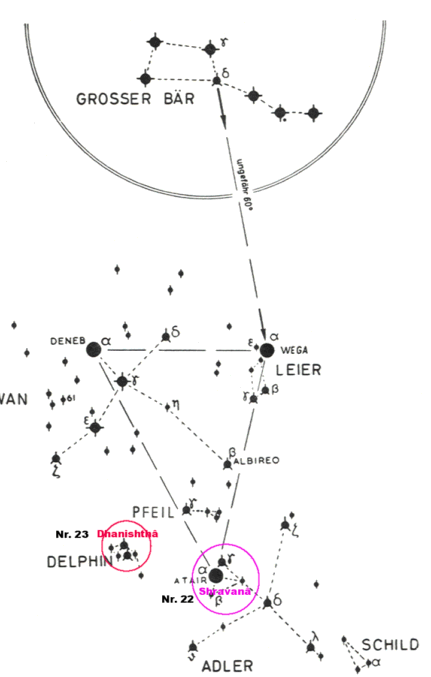
Abb.: Nakṣatra Nr. 22, 23
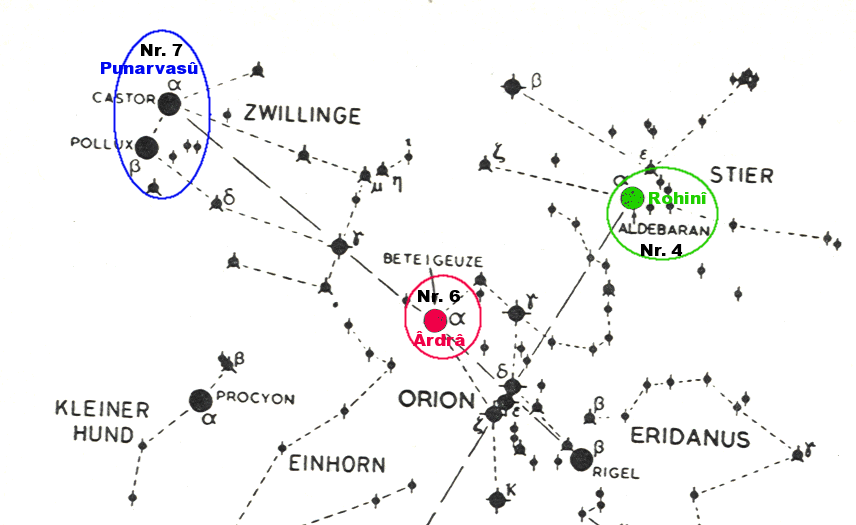
Abb.: Nakṣatra Nr. 4,6,7
[Quelle der unterlegten Sternkarten: Schroeder, Wolfgang: Praktische Astronomie für Sternfreunde. -- Stuttgart : Franckh, 1958. -- 180 S. : Ill. -- Originaltitel: Practical Astronomy (1956). -- passim]
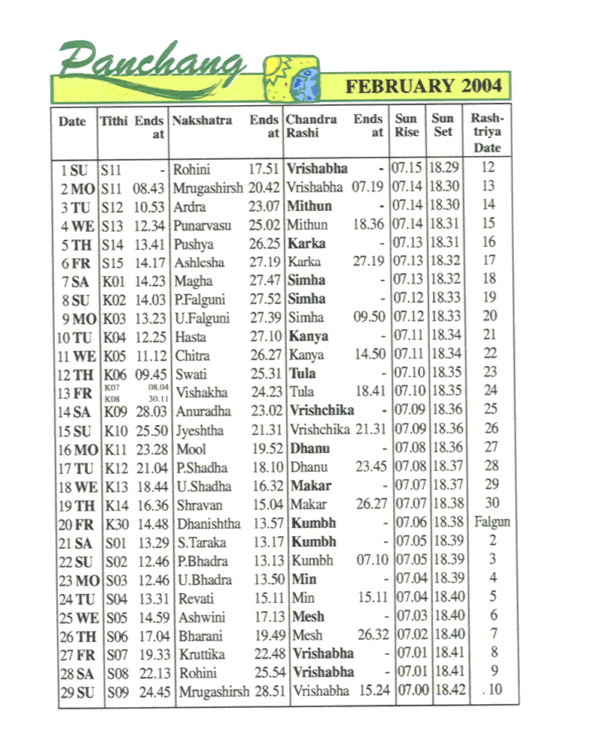
Abb.: Die Mondhäuser für Februar 2004 in einem indischen astrologischen Almanach
(Panchang) [als e-book erhältlich bei:
http://www.sulekha.com/epress/. -- Zugriff am 2004-02-09]
In der indischen Astrologie sind die Mondhäuser oft nur noch ein rechnerisches Phänomen. Wenige der indischen Astrologen scheinen imstande zu sein, die Mondhäuser am Sternenhimmel zu identifizieren.
Die Mondhäuser sind aber trotzdem (oder gerade deswegen: ein Astrologe braucht keine tiefen astronomischen Kenntnisse) von großer Bedeutung für die indische Astrologie.
Über die astrologische Bedeutung der Nakṣatra:
"A Unit To Measure Space A Nakshatra is a unit of measure of space. The zodiac consists of a 360 degree arc, which is further divided into 12 houses of 30 degrees each. It is again divided into 27 divisions of 13.20 degrees, each called Nakshatras or stars or constellations (Western) or Sieu (Chinese). Often, 28 Nakshatras are taken into account, curtailing the ownerhip area of three other Nakshatras from the standard 13.20 degrees. Each Nakshatra is the head of a particular group of stars.
How Nakshatras Affect You:The zodiac is divided into 28 Nakshatra divisions. Therefore, while transiting, the moon has to travel through one of the Nakshatras. When you were born, the degree or Nakshatra in which the Moon was situated at that time is called your birth star or Janma Nakshatra or constellation. If you know your Janma Nakshatra, more accurate predictions can be made about your future. For instance, if your Moon is in Vishaka Nakshatra, the following is just one of the many glimpses that the particular placing reveals : " You are a very good orator and have the capacity to attract a crowd. You will win several prizes in elocution competitions. Hence you will be the fittest person to enter politics. There is a peculiar spending tendency. While on the one side you are a very careful spender, on the other side you may be extravagant in spending where it is not required. You are fit for doing an independent business, or a job involving high responsibility, banking and religious professions, mathematician or a teacher or a printer."
You can also ward off the evil effects of Nakshatras through remedial measures. Nakshatras are also associated with colours, symbols, deities, etc and each of these associations can be used advantageously.
Nakshatras And The Three Worlds:
Since ancient times, there is a belief that there are three worlds : Heaven (Swargam) --the abode of the Devas or Gods; Earth ( Bhoomi) -- the abode of Manushya or Man ; and Hell ( Narak) -- the abode of the Rakshaas or Demons. The Nakshatras too have been divided into three ' communities' or Ganas .
The Divine Community
- Acvini
- Mrgacisha
- Punarvasu
- Pushya
- Hasta
- Svati
- Anuradha
- Abhijit
- Cravana
- Revati
The Manly Community
- Bharani
- Rohini
- Ardra
- Purva-Phalguni
- Uttara-Phalguni
- Paurva-Asadha
- Uttara-Asadha
- Purva-Bhadrapada
- Uttara-Bhadrapadra
The Demonical Community
- Krttika
- Aclesha
- Magha
- Citra
- Vicakha
- Jyestha
- Mula
- Cravishtha
- Catabhishaj
[Quelle: http://astrospeak.indiatimes.com/articleshow/902646660.cms. -- Zugriff am 2003-12-30]

Abb.: Āryabhatta und Varāhamihira: Wandgemälde von Kumud Patel, im Parliament
House, New Delhi [Bildquelle:
http://www.parliamentofindia.nic.in/intro/pan32.htm. -- Zugriff am
2004-02-09]
Der bedeutenste indische Astrologe, Varāhamihira (gestorben 587 n. Chr.), behandelt im 14, 15, 98., 99., 101. Kapitel seines Werkes Bṛhat-samhitā verschiedene Aspekte der Nakṣatra (Mondhäuser): Im Folgenden sind einige dieser Kapitel wiedergegeben.
Sanskrittext der Brhadsamhitā online:
http://lavanya.aros.net/sanskrit/all_pdf/varbrhs.pdf. -- Zugriff am 2004-02-11
[Kṛttikā]
1. The star Kṛttikā presides over the following :
[In the preceding chapter the author gives the rulership of the nine triads of stars over the nine regions or quarters and the peoples and countries situated therein. In this chapter he gives various things and types of persons that are ruled by the 27 asterisms severally. Rulership of the four Vargas or classes is separately given in 28-29 infra.]
[Rohiṇī]
2. The following are ruled by Rohiṇī :
[Bhaṭṭotpala construes the word Panya as Paṇyavṛttayaḥ i.e. merchants.!
[Mṛgaśiras]
3. The following are allotted to the constellation Mṛgaśiras :
[Ārdrā]
4.
all these are assigned to star Ārdrā.
[Punarvasu]
5. Under Punarvasu are placed
[Bhaṭṭotpala construes Vaṇijaḥ as Kiṃtaḥ here as well as in V. 40.]
[Puṣya]
6. Under Puṣya come
[Āśleṣā]
7. To Āśleṣā are assigned
[In Āyurveda many types of Cikitsa-treatment— such as Śalya, Salakya, Kayacikitsa etc. are mentioned.]
[Maghā]
8. The following are ruled by Magha :
[The commentator takes the word Koṣṭhāgara to mean Vipulagrāmah, large villages.]
[Pūrvaphalgunī]
9. The following are presided over by Pūrvaphalgunī:
[Uttaraphalgunī]
10. Star Uttaraphalgunī signifies
[Hasta]
11. Hasta rules
[Citrā]
12. Citrā presides over persons skilled in
[Svātī]
13. Under the jurisdiction of Svātī are placed
[Instead of Panya some texts read Vanya. That should be translated as those who are experts in forest-products.]
[Viśākhā]
14. Visakha rules
[Anurādhā]
15. Anuradha rules
[Jyeṣṭhā]
16. To Jyesthā belong
[Mūla]
17. Mūla rules
[Pūrvāṣādha]
18. Pūrvāṣādha presides over
[Uttarāṣādha]
19.
—all these come under Uttarāṣādha.
[Śravaṇa]
20. To Śravaṇa belong
[Dhaniṣṭhā]
21. Dhaniṣṭhā rules the following :
[Śatabhiṣaj]
22. The following come under the star Śatabhiṣaj :
[Pūrvabhadrapada]
23. Under Pūrvabhadrapada are placed
[Uttarabhadrapada]
24.
—all these are ruled by Uttarabhadrapada.
[Revatī]
25. Revatī rules
[Aśvinī]
26. Aśvinī rules
[The commentator interprets Vanijah as Kirātāh, Krayavikrayaniratāh.]
[Bhāraṇi]
27. Bhāraṇi rules
[In the following three verses the author alludes to the groups of stars that rule the classes or Varṇas.]
28.-30.
[Here the author divides human beings into the wellknown five classes including the outcasts and two more classes viz. husbandmen, and cruel persons. The last category is likely to include all unruly elements in society who may violate all norms of civilized society. These verses are in Upajāti metre.
[In the next two verses definition and effect of Upahata are given.]
31.-32. A lunar mansion is said to be Upahata or Afflicted
When a constellation is thus afflicted, all the people and things coming under its jurisdiction will be harmed Otherwise they will prosper.
[In mundane astrology this subject matter will be of great use. As we consider the effects of transits of different planets with reference to an individual's natal Moon, even so transit-effect can be gauged for different groups of persons as well as articles according to the method enunciated in this chapter as elsewhere. ]
[Übersetzung: Varahamihira's Bṛhat samhita = Bṛhatsamhita : with English translation, exhaustive notes and literary comments / M. Ramakrishna Bhat. -- Delhi : Motilal Banarsidass. -- 2 vol. -- Vol. 1. -- 1981. -- ISBN 81-208-0098-2. -- S. 185-190]
1.-3. The number of stars constituting the constellations from Aśvinī are
[Die Namen der Mondhäuser und die darin identifizierten Sterne sind meine Ergänzung, Varāhamihira nennt nur die - fett wiedergegebenen - Zahlen]
respectively.
The periods also of these constellations are represented by the number of stars.
The effect, good or bad, of an asterism at a marriage will come to pass in as many years as there are stars in it. A fever or some other ailment will disappear in so many days.
[In verse 2 bhūtashara is another reading. Its meaning would be 5 and 5. The star Mṛgaśiras is highly praised for marriage. It consists of three stars. So the beneficial effects of a marriage should be realized in 3 years. Similarly, the bad effects of forbidden stars, e.g. Ārdrā, will be felt in one year. If a person falls ill on a day ruled by Viśākhā, he should be free from it in 5 days.
In the next two verses the presiding deities of the constellations are given.]
4.-5. The presiding deities of the 28 asterisms beginning with Asvini are
respectively.
6. Among these 28 constellations the four viz.
are called Dhruva or Fixed. Coronations, expiatory rituals, planting of trees, laying the foundation of towns, commencement of meritorious deeds, sowing seeds and other permanent things should be undertaken when the Moon passes through these asterisms.
7. The following asterisms are called Tīkṣna (Daruna—dreadful):
These are good for success in attacks, incantations, raising of goblins, imprisonment of others, murders, separation of friends and alliance with kings and the like.
8. The following five asterisms are termed Ugra or Fierce:—
They are to be used with success in ruining enemies, destruction, deceit, imprisoning, poisoning, arson, striking with weapons and murders and the like.
9. The asterisms
are termed Kṣipra or Swift. They are beneficial in trade, sensual sports, education, decorations (or making ornaments), fine arts, skilled labour (like carpentery, smithy etc.), medical treatment, journey and the like (taking or giving loan etc).
10. The four asterisms,
are known to belong to the class of Mrdu or Tender ones. They are used with advantage in making friends, sexual union, use of garments and ornaments, performance of auspicious ceremonies (like marriage, Upanayana and Cudakarana) and singing.
11. The two asterisms
are known as Mrdu-tīkṣna or Tender-Dreadful (or Sādhārana) and yield mixed results.
The five asterisms
are termed Cara or Temporary and are beneficial for emphemeral things.
12. The asterisms recommended for shave are
It is to be had when these asterisms rise, or when the Muhūrtas bearing the names of the deities presiding over the asterisms are current, when the Moon is auspscious i.e. passing through the
1st, 3rd, 6th, 7th, 10th or 11th
with respect to the Janma-rāshi (sign occupied by the natal Moon) and when the asterism is favourable to the person concerned i.e.
from his natal one.
[There are five conditions mentioned here, viz.
- the asterism ruling the day,
- the ascendant,
- the Muhūrta,
- Candranukūlya and
- Tārānukūlya.
Of these four are essential, the second and third being interchangeable. If one cannot get the proper Muhūrta, one can have any of these stars on the ascendant. For example Aśvinī is one of the stars permitted for shave. Now Aśvinī will be on the ascendant when 13°20' of Aries rise. To get at an appropriate Muhūrta proceed thus: There are 15 Muhūrtas in the daytime and an equal number in the night. Each Muhūrta has a name, as shown in the verse quoted below. If this name and that of the deity owning an asterism are the same or synonymous, the Muhūrta is beneficial. The deity of Hasta is Sūrya and the third Muhūrta of the day is called Mitra meaning the Sun. So one can opt for this Muhūrta. For the names of the Muhūrtas refer to Yātnā—
This and the following verse are in Vasantatilakā metre.]
13. It is not advisable to have a shave
14. Shaving is approved under all asterisms, if there is a royal command, advice of Brahmanas, the occasion of a marriage, pollution caused by death, release from prison, and consecration for a sacrifice.
[This verse is in Upajāti metre, while verse 16 is in Indravajrā]
15. The asterisms
are auspicious for all masculine sacraments or works.
['Marriage' is a masculine sacrament, but Punarvasu is not one of the prescribed stars for that. This verse is not found in some editions. Hence it may be an interpolation, since Utpala's commentary is not found. Moreover the same idea is repeated in the next verse.]
16. Sacraments (like the naming ritual), consecrations (for sacrifices), vows, upanayana (initiation of a twice-born boy into religious studentship) and such other things (like the tonsure ceremony) should be performed on a
when the Moon is in conjunction with
17. All undertakings will be crowned with success, if the
are uncontaminated (i.e. not occupied by malefics), the malefics occupy the
house (from the Lagna), and Jupiter or Venus, the ascendant or any other Kendra. A house should be constructed or entered when the rising Sign and the one occupied by the Moon are favourable to the owner (i.e. when they do not happen to be the 12th or 8th from his natal ascendant and Moon) and when the ascendant happens to be a rural and fixed sign.
[The rural signs are
- Aries,
- Taurus,
- Gemini,
- Virgo,
- Libra,
- Sagittarius and
- Aquarius.
Of these only two viz. Taurus and Aquarius, are fixed signs. But Aquarius is not good as the ascendant.
The metre is Shārdūlavikrīdita.]
[Übersetzung: Varahamihira's Bṛhat samhita = Bṛhatsamhita : with English translation, exhaustive notes and literary comments / M. Ramakrishna Bhat. -- Delhi : Motilal Banarsidass. -- 2 vol. -- Vol. 2. -- 1982. -- ISBN 81-208-0301-9. -- S. 866-873]
1.-3. The lords of the lunar days are in their order:
those of the New Moon are the Manes.
Functions appropriate to the presiding deities must be performed on their respective Tithis.
These are further divided into five classes of three days each:
Works that are prescribed for the several asterisms should be done on the lunar days that are owned by the same deities. In the same manner, they should be done with reference to the Karanas and Muhūrtas by the identity of the presiding deities for ensuring success.
[Since Brahman presides over the
- first lunar day, all Brahminic ceremonies such as marriage may be performed that day;
- on the second, laying of foundations for houses etc.;
- on the 3rd tonsure etc.;
- on the 4th, things for harming enemies etc. may be undertaken;
- on the 5th, emetics, tonics etc. may be taken;
- on the 6th, getting new friends coronation etc. may be done;
- on the 7th, construction of vehicles, journeys etc;
- on the 8th, taking up of arms, fortification etc.;
- on the 9th, ruining and killing enemies;
- on the 10th, meritorious deeds, worship of Brahmanas, etc.;
- on the 11th, things that are permanent, ephemeral, iand tender;
- on the 12th, installation of the sacred fire, etc.;
- on the 13th, forming friendship, enjoyment of sensual pleasures etc.;
- on the 14th, administration of poison, mercury, etc.;
- on the 15th, propitiation of the Manes, etc.
- Since Rohiṇī star and Pratipad (I lunar day) are presided over by Brahman, all the works that are allowed under the star can be performed on the Tithi too.
- Similarly, it is with regard to the star Abhijit and the second lunar day;
- Śravaṇa and the 3rd day;
- Bhāraṇi and the 4th;
- Mrgashīrsha and the 5th;
- Kṛttikā and the 6th;
- Jyeshtha and the 7th;
- Hasta and the 12th;
- Pūrvaphalgunī and the 13th;
- Āshleshā and the 14th,
- Uttarāshādhā and the 15th; and
- Maghā and the New Moon.
As asterisms and lunar days are treated on a par with each other on account of their common rulership, even so are the lunar mansions and the Karanas:
- Jyeṣṭhā and Bava Karana;
- Rohiṇī and Bālava;
- Anurādhā and Kaulava;
- Uttaraphalgunī and Taitila;
- Jyeṣṭhā and Gara;
- Śravaṇa and Vaṇij;
- Bhāraṇi and Viṣṭhi;
- Āshlesā and Śakuni;
- Rohiṇī and Catuṣpād;
- Āśleṣā and Nāga;
- Svāti and Kiṃstughna.
The pairs of asterisms and Muhūrtas having common rulers are the following:—
- Ārdrā and Śiva;
- Āshleshā and Bhujaga;
- Anurādhā and Mitra;
- Maghā and Pitṛ;
- Dhanishthā and Vasu;
- Pūrvāshādhā and Jala;
- Uttarāshādhā and Vishva;
- Abhijit and Virañci;
- Rohiṇī and Brahman:
- Viśākhā and Indrāgni;
- Mūla and Nairrta;
- Shatabhishaj and Varuṇa;
- Uttaraphalgunī and Aryaman;
- Pūrvaphalgunī and Bhāgya;
- Pūrvabhadrapadā and Ajaikapāda;
- Uttarabhadrapadā and Ahirbudhnya;
- Revatī and Pūṣan;
- Aśvinī and Dasra;
- Bhāraṇi and Antaka (Yama);
- Kṛttikā and Āgneya;
- Mṛgaśiras and Indu;
- Punarvasu and Aditi;
- Pushya and Guru;
- Śravaṇa and Hari;
- Hasta and Ravi;
- Citrā and Tvaṣṭṛ; and
- Svāti and Anila.
[Übersetzung: Varahamihira's Bṛhat samhita = Bṛhatsamhita : with English translation, exhaustive notes and literary comments / M. Ramakrishna Bhat. -- Delhi : Motilal Banarsidass. -- 2 vol. -- Vol. 2. -- 1982. -- ISBN 81-208-0301-9. -- S. 874-878]
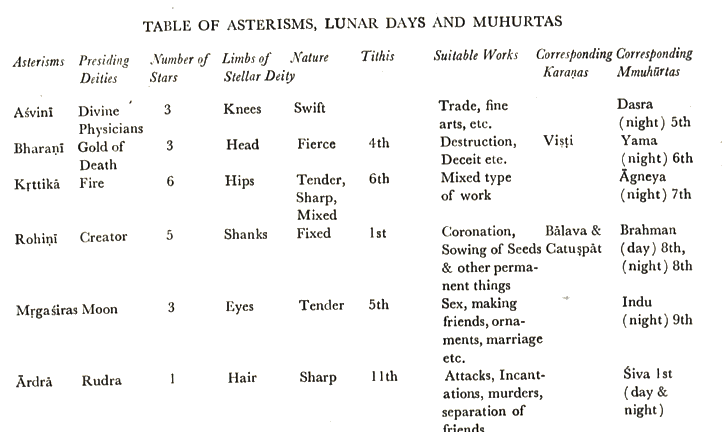 |
 |
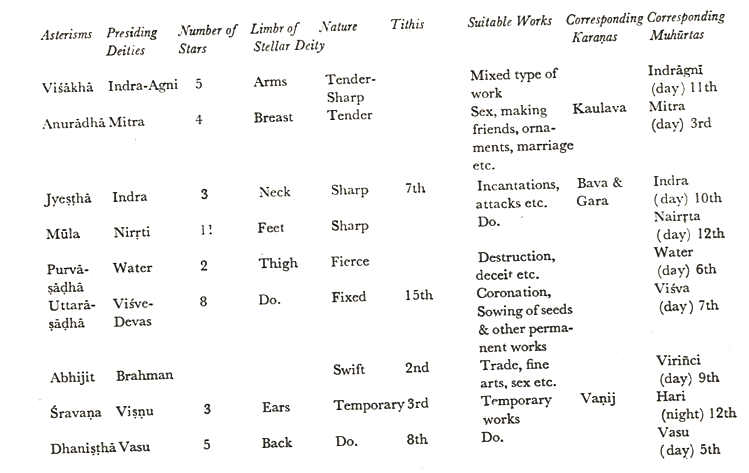 |
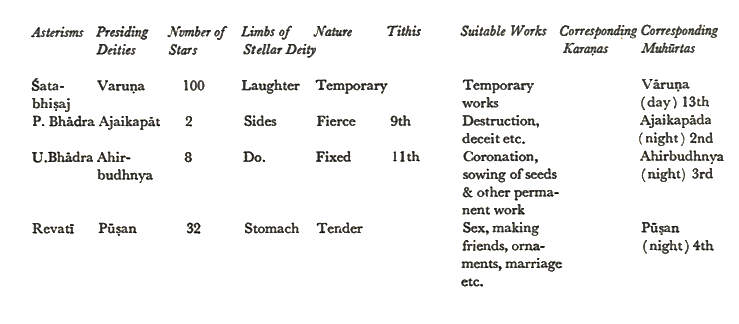 |
| [Quelle der Tabellen: Varahamihira's Bṛhat samhita = Bṛhatsamhita : with English translation, exhaustive notes and literary comments / M. Ramakrishna Bhat. -- Delhi : Motilal Banarsidass. -- 2 vol. -- Vol. 2. -- 1982. -- ISBN 81-208-0301-9. -- S. 879-882] |
This chapter is a mere repetition of XVI of the Brhad Jātaka.
1. One born under the asterism Aśvinī will be fond of ornaments, lovely in appearance, attractive or liked by all, efficient and intelligent.
The asterism Bhāraṇi makes one carry out one's determination, truthful, free from ill health, efficient and happy.
[Thus, we see that the effects of both Aśvinī and Bhāraṇi are quite good according to our author; but, according to Parāshara, Bhāraṇi makes one cruel, untruthful, fickle-minded, a thief etc.]
2. Birth under the asterism Kṛttikā makes one a glutton, addicted to others' wives, brilliant and famous.
The person born under Rohiṇī will be truthful, pure, sweet-tongued, with a steady mind, and lovely in appearance.
[Sage Parāshara gives a good certificate in the following verse to one born under Kṛttikā. The effects of Rohini arc a little better here.]
3. One born under the star Mrgashīrsha becomes fickle, clever, timid, eloquent, industrious, wealthy and endowed with sensual pleasures.
The asterism Ārdrā makes one perfidious, haughty, (irascible), ungrateful, cruel and sinful.
4. One born under the star Punarvasu will be self-controlled, happy, of good character, dull-witted, ailing, very thirsty and easily satisfied.
5. One born under the star Pushya will possess a tranquil mind, amiable features, learning, affluence and attachment to meritorious deeds.
The asterism Āśleṣā makes one insincere, inclined to eat everything, sinful, ungrateful and deceitful.
6. A person whose birth takes place tinder the star Maghā will be very rich and will have many servants, will enjoy pleasures, worship the Gods and the manes, and be very industrious.
The star Pūrvaphalgunī makes one sweet-tongued, liberal in gifts, bright in appearance, fond of wandering, and a servant of the king.
7. The person born under the star Uttaraphalgunī will be very popular, will earn money by his learning, will be voluptuous and happy.
The star Hasta makes one industrious, impudent, fond of drinking, merciless and thievish.
8. Under the asterism Citrā one comes to have colourful garments and flower-garlands as well as beautiful eyes and limbs.
The star Svāti makes one self-controlled, clever in trade, kind-hearted, virtuous and of pleasant speech.
9. One born under Viśākhā becomes jealous, greedy, bright in appearance, clever in speech, and quarrelsome.
The person born under Anurādhā becomes very wealthy, dwells in foreign lands, is unable to endure hunger and wanders from place to place.
10. One born in the star Jyeṣṭhhā will not have many friends, will be contented, interested in meritorious deeds and exceedingly irritable.
Under Mūla one becomes proud, wealthy, happy, of a gentle nature, firm-minded and luxurious in his living.
11. The person born under Pūrvāṣādhā will have an amiable and jolly wife, will be proud and firm in friendship.
The star Uttarāshāhā will make one modest, virtuous, have many friends, grateful and attractive.
12. One born under the asterism Śravaṇa becomes learned, has a generous wife, and is possessed of wealth and fame.
Star Dhaniṣṭhā makes one charitable, heroic, wealthy, greedy for money, and fond of music.
13. One born in the star Śatabhiṣaj speaks clearly (or frankly), is unfortunate (or has some vice), conquers his enemies, is daring and hard to be won over.
Under the star Pūrvabhadrapadā one will be unhappy, henpecked, wealthy and clever, but a miser.
14. The person born under the asterism Uttarābhādra will be a good speaker, happy, blessed with children, will vanquish his enemies and be virtuous.
The star Revatī makes one have a symmetrical body (a perfect body), attractive, heroic, pure and wealthy.
[Übersetzung: Varahamihira's Bṛhat samhita = Bṛhatsamhita : with English translation, exhaustive notes and literary comments / M. Ramakrishna Bhat. -- Delhi : Motilal Banarsidass. -- 2 vol. -- Vol. 2. -- 1982. -- ISBN 81-208-0301-9. -- S. 888-893]
Die Rezitation eines Nashatradevatā-mantras kann man online hören unter: http://www.musicindiaonline.com/music/l/02000H001001. -- Zugriff am 2004-02-12
1. - 5.
In this manner, the form of the Stellar Deity has to be constituted by those who wish for good physical features.
[It is well known that the 12 signs of the zodiac represent the various limbs of the Kālapurusha. Likewise.the 27 asterisms are distributed among the limbs of the Nakshatra-purusha. It is an accepted principle in Sanskrit literature that description of heavenly beings should start with the feet and go upwards. The exact meaning of is 'the sacrifice of the form'.]
6. One should worship Lord Viṣṇu and the Stellar Deity and then observe fast on the 8th day of the dark fortnight in the month of Caitra, when the Moon passes through the asterism Mūla, synchronizing with Monday.
[The fast and worship should be gone through in the order of the limbs of the Nakshatra-purusha i.e. after Mūla, it should be done on a day ruled by the asterism Rohiṇī, and then by Aśvinī and so on, until the last asterism viz. Ārdrā, is reached.]
7. When this observance has been completed, the performer should make a gift of a vessel filled with ghee, along with gold, gems and clothes, according to his means, to a Brāhmaṇa, well versed in astrology.
8. A person wishing for attractive features should worship and feed Brāhmaṇas with dishes prepared in milk and ghee, mixed with jaggery; he should also present them with gold, silver and clothes. Then he should fast regularly on the days when the Moon passes through the several asterisms beginning with Mūla and representing the various limbs of the Stellar Person, and also worship, in accordance with the rules of the Pancarātra system of worship, Lord Hari, and the Stellar Deity.
[There are many systems of worship, the chief of which are the Pancarātra, Vaikhānasa and Pāshupata. The metre is Shārdūlavikrīdita.]]
9. A man who performs this worship of the Stellar Deity will have (in the next birth) long arms (touching the knees), broad and muscular breast, moon-like face, white and beautiful teeth, the gait of lordly elephant, long eyes resembling the lotus, a personality that captivates the hearts of damsels, and a body verily like that of Cupid.
[The metre is Upajāti.]
10. - 12. A woman who performs this worship will be born with a face as bright and lustrous as the autumnal full Moon, eyes like the petals of lotus, beautiful (and sparkling) teeth, fine ears, hair resembling the belly of the bees, a voice as sweet as that of an intoxicated cuckoo, red lips, hands and feet as tender and charming as lotus-petals, a slender waist bending under the weight of the bosoms, a navel with turns from left to right, thighs similar to banana trunks, fine buttock and excellent loins. She will win the love of her husband, and have well-knit toes. These results accrue, pari passu, to men as well.
I think that verses 9 to 12 form one unit, and the subject of verse 9 is given at the end of verse 12. Hence it is not necessary to construe manushyash ca as 'the woman may also be born a man'. Here the author like Kālidāsa, has heaped together all the available standards of comparison.]
13. Such a person, man or woman, (as has performed this worship) will become a star and move with the stars in the firmament, as long as the rows of stars move in the sky and illumine the world, till the end of the Creator's day i.e. Kalpa. And when the universe is re-created, the person will become a wise monarch; and will be reborn in the world as a king or a rich Brihmana.
[With this the topic of 'the Sacrifice to the form of the Stellar Deity' is concluded. The following verses give names of nionths. The metre of this verse is Sragdharā.]
[Übersetzung: Varahamihira's Bṛhat samhita = Bṛhatsamhita : with English translation, exhaustive notes and literary comments / M. Ramakrishna Bhat. -- Delhi : Motilal Banarsidass. -- 2 vol. -- Vol. 2. -- 1982. -- ISBN 81-208-0301-9. -- S. 934-937]
"NAKSATRAYOGA. It is ordained in the Purānas that alms-giving on each star or day will be rewarded by particular attainments. This is called Nakshatrayoga. The Nakshatrayoga of each star is given below:—
- Aśvayuk:— Those who give horses and chariots as alms on this day, would be born again in a noble family.
- Bhāraṇi:— If lands and cows are given to Brahmins on this day, one would get a large number of cows and will become famous in heaven.
- Kṛttikā:— If rice-pudding is given to Brahmins to their satisfaction on this day the giver will attain the prominent worlds after death.
- Rohiṇī:— If milk-rice and venison mingled with ghee is given to Brahmins on this day, his indebtedness to the manes would end.
- Mṛgaśiras:— (Candra nakshatra). If a milch-cow is given as alms on this day, one would attain heaven.
- Ārdrā:— If fast is taken and gingelly oil is given as alms on this day, the giver will become capable of crossing mountains and trenches.
- Punarvasu:— He who gives bread on this day will be born again in a good family.
- Puṣya:— He who gives gold as alms on this day will enter the world of bright planets.
- Āśleṣā:— He who gives an ox made of silver as alms on this day, will become fearless.
- Maghā:— He who gives gingelly as alms on this day will become prosperous with cows.
- Pūrvaphalgunī:— If ghee-rice is given to Brahmins taking fast on this day, the giver would become happy and prosperous.
- Uttaraphalgunī:— He who gives rice of Nivara variety mixed with milk and ghee on this day will be honoured in heaven.
- Hasta:— If one gives four horses and an elephant as alms, on this day, one will attain the world of bliss.
- Citrā:— He who gives oxen and perfumery as alms on this day, will enter the parks in which celestial maids stay.
- Svātī:— He who gives any sort of wealth as alms on this day will become renowned in the worlds.
- Viśākhā:— He who gives as alms on this day, oxen, milch-cow, grain-box, cart, paddy and diamond will attain heaven.
- Anurādhā:— He who gives cloth, rice and blanket on this day will be honoured in heaven for a hundred yugas.
- Jyeṣṭhā:— If Brahmins are given yams and greens on this day one could realize one's wishes.
- Mūlā:— The manes will be contented, if Brahmins are given roots and nuts on this day.
- Pūrvāṣādhā:— If Brahmins who are expounders of Vedas are given as alms pots of curd, after observing fast, the givers will take birth again in families with many cows.
- Uttarāṣādhā:— He who gives milk and ghee to wise men will be honoured in heaven.
- Śravaṇa:— Those who give cloth and rug on this day will enter a white conveyance and reach heaven.
- Śraviṣṭhā:— Those who give cattle, cart and cloth on this day will enter heaven.
- Śatabhiṣak:— Those who give sandalwood and aloe wood on this day, will go to the world of devas (gods).
- Pūrvaproṣṭhapada:— He who gives coins on this day will reach the world of bliss.
- Uttaraproṣṭhapada:— Those who give mutton on this day will be pleasing the manes.
- Revatī.— He who gives cows which could give potfuls of milk, could reach any world.
(Mahābhārata, Anushāsana Parva, Chapter 64)."
[Quelle: Mani, Vettam [Vettammāni] <1921 - >: Puranic encyclopaedia : a comprehensive dictionary with special reference to the epic and puranic literature. -- 1. ed. in engl.. - Delhi : Motilal Banarsidas, 1975. - VIII, 922 S. -- ISBN 0-8426-0822-2. -- Originaltitel: Purananighantu (1964). -- S.517f.]
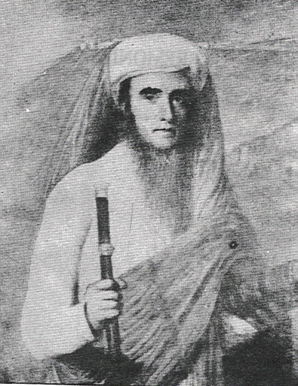
Abb.: J.A. Dubois 1766-1848
J.A. Dubois 1766-1848
10.1. 1766 Geburt und Taufe in St. Remèze/Ardèche.
ca. 1775-1792 Schulbesuch in Bourg-St.Andéol, Besuch des Priesterseminars am Séminaire des Missions Étrangères in Pairs, Priesterweihe.
31 Jahre in Indien
29.1. 1792 Einschiffung nach Indien (Pondichéry/Malabarküste).
1794 Wegen der revolutionären Ereignisse Rückzug nach Tranquebar; Überlegungen, wegen der politischen Situation im französischen Pondicherry als Missionar nach China / Macao zu gehen.
1799 Betreuung der von Tippu Sultan zwangsbekehrten Christen in Srirangapatnam
1803-1804 Erfolgreiche Pockenimpfung im Mysoregebiet, für die er eine Jahrespension von 2.000 Francs von der East India Company erhält; zahlreiche Kirchenbauten, landwirtschaftliche Versuchskolonie in Sathally. Dubois spricht fließend Englisch, Tamil, Kannada und Telugu.
1815 Briefe an den Diakon von Bombay, Barnes, zum "Stand der Christenheit in Indien", mit der umstrittenen Ansicht vom Ende der Mission; die Thesen lösen in Europa heftige Kontroversen aus.
1816, 1819 zum Nachfolger des Seminardirektors in Paris und als Kandidat für das Bischofsamt in Madras vorgeschlagen; lehnt aus Gesundheitsgründen ab.
1817 Erstausgabe der englischen Fassung: Description of the character, manners, and customs of the people of India; and of their institutions, religious and civil. Translated from the french manuscript. London : Longman u.a. 1817.
1823 Aus Indien zu den Missions Étrangères nach Paris zurückbeordert; Letters on the State of Christianity in India, in which the Conversion of the Hindoos is considered as impracticable. To which is added a vindication of the Hindoos, male and female. London 1823 in Buchform; es erscheinen zwei Entgegnungen.
1825 Erstausgabe der französischen Fassung durch den Abbé selbst: Mœurs, institutions et cérémonies des peuples de l'Inde; par M. l'Abbé J. A. Dubois, ci-devant missionnaire dans le Meissour, membre de la Société Royale Asiatique de la Grande-Bretagne et de l'Irlande, de la Société Asiatique de Paris, et de la Société Littéraire de Madras. 2 Bde. Paris 1825.
1825 Exposé de quelques-uns des principaux articles de la théogonie des Brahmes: contenant la déscription détaillée du Grand Sacrifice du Cheval, appelé Assma-Méda; de l'origine et des grandeurs du Gange; du temple célèbre de Gaya; des principaux Avataras, ou incarnations de Vichnou, etc. Paris 1825.
1826 Le Pantcha-Tantra, ou les cinq ruses: fables du Brahme Vichnou-Sarma; aventures de Paramarta, et autres contes. Visnusarman. Paris 1826.
1830-1832 Englandaufenthalt
1832-1845 Assistent und Superior des Seminars der Missions Étrangères in Paris.
17.2.1848 Bei seinem Tod hinterlässt Dubois sein Vermögen der Mission und der heimischen Gemeinde in St. Remèze für Schulzwecke.[Quelle: http://www.abbe-dubois.de/lebenundwerke/index.html. -- Zugriff am 2004-02-09]
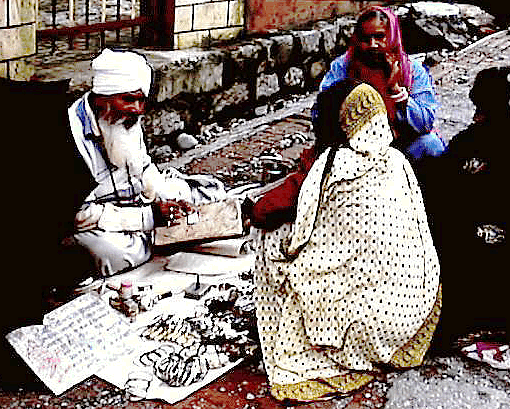
Abb.: Straßenastrologe, Nainital / Fotografie von Michio Yano [Bildquelle:
http://www.kyoto-su.ac.jp/~yanom/pictures/astrg01.jpg. -- Zugriff am
2004-02-11]
"ASTROLOGY. Astrology, together with the silly notions which originate from it, has at all times exercised a great influence over the nations of the world, civilized as well as uncivilized. In Europe the appearance of a comet or a total eclipse formerly spread the greatest terror in the minds of the multitude, who looked upon these celestial phenomena as the forerunners of some public calamity ; and even at the present day these chimerical fears still exercise some influence over the imagination of the ignorant and superstitious.
The influence of the stars, scrutinized with the eyes of reason, need not be looked upon altogether as an idle imagining ; and there is doubtless a happy medium to be observed between the widely divergent opinions of authors concerning the action, more or less direct, more or less limited, exercised by the stars over the vegetable and animal kingdoms of this earth of ours. Be this as it may, however, no other nation appears to. have carried its astrological notions to such extremes of folly as the Hindus. With their wonted exaggeration in all things, it is only natural that they should entertain wild ideas about a science which opens so vast a sphere to the imagination. All the rubbish they have written on this subject would certainly be too tedious to read. I will, therefore, content myself with referring briefly to a few of the important principles on which their so-called science of astrology rests.
Each planet in turn is supposed to exercise its influence during the space of a year. The ruling planet is attended by another, which plays the part of a minister. The latter assumes in the following year the supreme functions of the former ; and so on year after year.
Some of these planets are beneficent, others the reverse.
The Moon, Mercury, Jupiter, and Venus are of the former order. Under their sway everything thrives: men live happily and are blessed with abundance ; the fertile fields yield rich harvests, and the fruitful trees bear abundantly.
The Sun, Mars, and Saturn, on the other hand, have a tendency to cause evil to animate as well as to inanimate nature. Their reign is, therefore, almost always disastrous. Men are oppressed with sickness; they attain success in nothing; they experience only troubles and disappointments : moreover, the rains hold off, the soil becomes unfruitful, famine and misery everywhere prevail.
When, however, an unpropitious planet has for its attendant minister a planet of an opposite character, and vice versa, the good one counteracts and counterbalances, at least to a certain degree, the evil influence of the other.
Thus one can expect to enjoy unalloyed happiness only during those years when two benign planets hold their sway at one and the same time. Similarly, one must dread continual misfortunes when both planets have an evil inclination to harass unfortunate mankind.
There are four principal clouds which yield rain, and each in its turn discharges this duty for the space of one year. Their names are
- Samvarta,
- Avarta,
- Pushkala,
- Drona.
The first and the last are favourably disposed towards mankind, and yield copious showers. Avarta and Pushkala, on the other hand, produce nothing but storms and hurricanes, and are sparing of the rain which refreshes and fertilizes the soil.
The frequency of rain depends also to a great extent on the good or bad will of seven elephants. Each of these is known by its own name, and each in turn is charged with the annual duty of carrying water to the clouds. Four of them display great activity in the discharge of their duty, and supply the clouds with an ample provision of rain. But the other three acquit themselves very carelessly of their duty during their terms of service ; consequently the ground remains parched up, and scarcity prevails.
Seven snakes, each also bearing a particular name, exercise in turn for the space of one year supreme authority over all species of snakes.
- The snake Ananta, the first one, is the most powerful of all, and supports the earth on its head. The year of its reign is considered unhappy, inasmuch as snakes are then extremely venomous, and their bite invariably proves fatal.
- The reign of the snake Karkataka is equally unhappy.
- The remaining five are by no means equally mischievous. It is seldom that persons are bitten by snakes while these are in power ; and should a person be bitten, the bite does not prove fatal.
- The snake Maha-Padma particularly is the friend of men ; it not only prevents other snakes from harming them, but also comes to their aid by sending the physician Dhanmantari to cure such as may have been accidentally bitten.
By the combination of the twelve signs of the Zodiac with the planets and with the star which is in the ascendant on each day of the moon, Hindu astrologers believe themselves capable of telling the secrets as well as the future events of life.
The Sun remains thirty days in each of the signs of the Zodiac ; the Moon, two days and a quarter ; Mars and Mercury, a month and a half ; Jupiter, one year ; Venus, two years and a half ; Saturn, one year and a half.
Each sign of the Zodiac has, besides, two stars and a quarter, which are assigned to it from among the twenty-seven constellations or stars of the lunar month.
By comparing all these phenomena, and by joining, in regular order, certain words with the different signs of the Zodiac, they are enabled to know the past, the present, and the future, and to recover things that have been lost or stolen. The coincidence of these words is, for this purpose, combined with the sign of the Zodiac, the planet, the star, and the time of the day or night at which the astrologer is consulted.
By the same means it is possible to find out, not only the place wherein a stolen article is secreted, but also the sex and the caste of the thief. They are also able to ascertain whether or not the stolen or lost article will be recovered, according as the sign, the planet, and the star which correspond to the time at which the consultation takes place are favourable or the reverse.
They discover in the same way whether a person who has been long absent is dead or alive ; whether he is sick or in good health ; whether he is at liberty or in prison ; whether he will return or not.
But one of the most important combinations calculated is that relating to birth. In fact, according to the Hindus, the future lot of men is supposed to depend on the sign of the Zodiac and the star under which they are born. This is what they call lagnam. It is supposed that each of the twelve signs prevails over daily occurrences during a fixed interval of time.
Thus, for instance,
- the sign Aries (the Ram) prevails for two hours ;
- Taurus (the Bull) for two hours and a quarter ;
- Gemini (the Twins) for two hours and a half ;
- and so on.
Again, the sign which corresponds to the moment of birth is termed Janma-lagnam; and by combining it with the planet and the star of the day, they ascertain beyond a doubt whether the child is born to be happy or unhappy.
Of the seven days of the week, three are held to be unlucky, namely,
- Sunday,
- Tuesday, and
- Saturday.
On these days no important business ought to be undertaken, no journey begun.
Of the twenty-seven stars of each lunar month, seven are reputed to be more or less unlucky; and everything undertaken on the days on which these appear is attended with disastrous results.
The rest of the science is based on similar considerations."
[Quelle: : Dubois, J. A. (Jean Antoine) <1765-1848>: Hindu manners, customs and ceremonies / by J.A. Dubois ; translated from the author's later French ms. and edited with notes, corrections, and biography by Henry K. Beauchamp ; with a prefatory note by F. Max Müller and a portrait. -- 3rd ed. -- Oxford : Clarendon Press, 1906. -- 741 S. -- Originaltitel: Moeurs, institutions et cérémonies des peuples de l'Inde (1825). -- S. 379-382]
Zurück zu Kapitel 10,5: Hochzeit = Vivāha